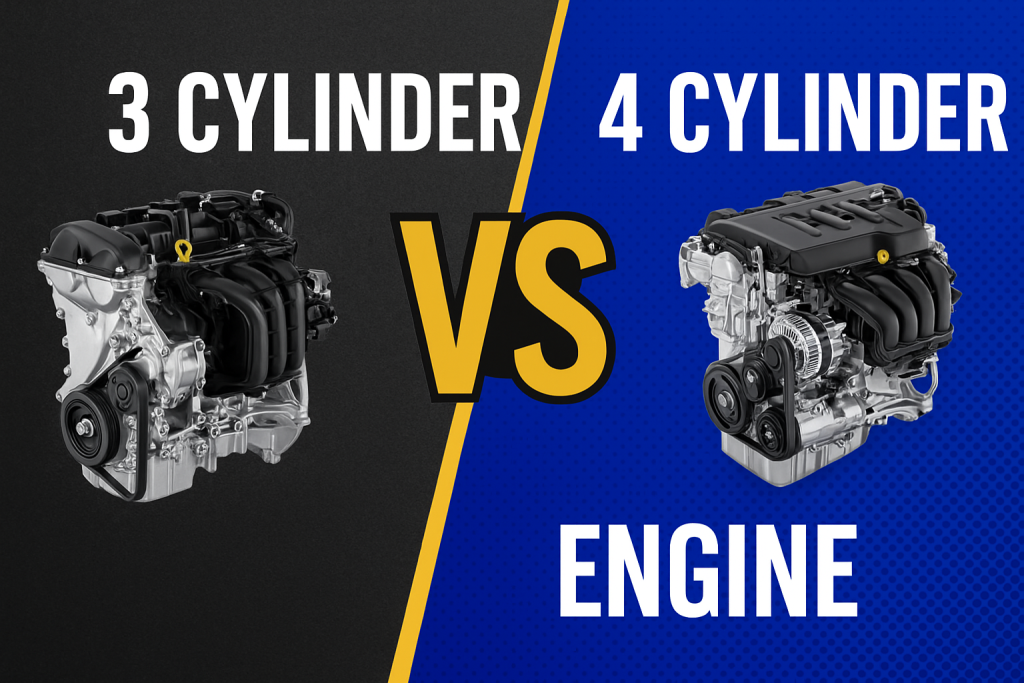The automotive world is buzzing with debate: 3 cylinder vs 4 cylinder engine—which configuration reigns supreme? Under the hood, the choice isn’t just about numbers. It’s about engineering finesse, driving dynamics, and real-world value. 3 cylinder engines are compact marvels, engineered for featherweight efficiency and remarkable torque delivery at low revs. This lightweight architecture doesn’t just mean better fuel economy; it translates to agile handling and an overall spirited drive, making every urban commute feel like an adventure.
On the flip side, the 4 cylinder engine is the steadfast workhorse—synonymous with balance, smooth power delivery, and long-haul reliability. With an extra cylinder, it offers refined acceleration and less vibration, appealing to those who demand both comfort and performance. The real advantage lies in how these features ripple through your daily experience: more miles per gallon, a lighter carbon footprint, and the thrill of immediate throttle response. Whether you crave eco-friendly motoring or unwavering endurance on the highway, the 3 cylinder vs 4 cylinder engine showdown is more than a spec sheet comparison—it’s a decision that shapes your driving story.
| Aspect | 3 Cylinder Engine | 4 Cylinder Engine |
|---|---|---|
| Number of Cylinders | 3 | 4 |
| Engine Size | Smaller, more compact | Slightly larger, more space-consuming |
| Fuel Efficiency | Generally higher due to lighter weight | Slightly lower, but still efficient |
| Power Output | Moderate, focused on low-end torque | Higher, with smoother power delivery |
| Vibration | More noticeable, can be reduced with balancing | Smoother and more refined |
| Cost | Typically less expensive to manufacture | Slightly higher production cost |
| Maintenance | Fewer parts, potentially lower cost | More components, possibly higher cost |
| Performance | Zippy for city driving, quick throttle response | Better acceleration, stronger highway cruising |
| Noise | Can be louder or have a unique growl | Quieter, less engine noise |
| Emissions | Lower, often used in eco-friendly cars | Slightly higher, but modern tech reduces this |
| Typical Application | Compact cars, small SUVs, hybrids | Sedans, SUVs, and performance-oriented models |
What Are 3 Cylinder Engines?
3 cylinder engines are compact powerplants designed with innovation at their core. Characterized by their trio of combustion chambers, these engines have rapidly become the darling of automotive engineers and eco-conscious drivers alike.
Key Features of 3 Cylinder Engines
- Compact Architecture: Their smaller footprint allows for lighter vehicle designs and more space-efficient engine bays.
- Impressive Fuel Economy: Fewer cylinders mean reduced internal friction and lower fuel consumption, translating into more miles per gallon.
- Turbocharged Performance: Many modern 3 cylinder engines are turbocharged, compensating for their size and delivering robust torque and peppy acceleration.
Advantages and Uncommon Attributes
- Lower Emissions: Designed for efficiency, they emit less CO₂, making them a favorite for hybrid and city-focused vehicles.
- Unique Engine Note: The odd number of cylinders creates a distinctive, throaty sound—an acoustic signature that sets these engines apart.
- Simplified Mechanics: Fewer moving parts can mean lower maintenance costs and enhanced reliability.
When considering the 3 cylinder vs 4 cylinder engine debate, the 3 cylinder engine’s blend of efficiency, modern engineering, and spirited performance positions it as a formidable choice for today’s dynamic drivers. The fusion of lightweight agility and innovative technology makes this engine configuration a true game changer in urban mobility.
Pros of 3 Cylinder Engines
- Exceptional Fuel Efficiency: The lightweight design and reduced internal friction mean these engines sip fuel, making them ideal for city commuters and eco-minded drivers.
- Compact Dimensions: Perfect for small cars, their minimal footprint enables innovative vehicle designs and increased cabin space.
- Lower Emissions: Their efficient combustion process results in less CO₂ output, catering to stringent environmental standards.
- Turbocharging Potential: Modern technology allows 3-cylinder engines to punch above their weight, delivering surprisingly spirited performance.
- Cost-Effective Maintenance: With fewer moving parts, the likelihood of mechanical issues is reduced, translating to potential long-term savings.
- Distinctive Driving Experience: The unique engine note and nimble handling offer a refreshing alternative in the ongoing 3 cylinder vs 4 cylinder engine conversation.
A fusion of practicality, innovation, and personality, the 3-cylinder engine carves a compelling niche in today’s automotive landscape.
Cons of 3 Cylinder Engines
- Increased Vibration: With one less cylinder, these engines can exhibit more noticeable vibrations, especially at idle or low speeds, compared to their four-cylinder counterparts.
- Limited Power Output: While modern turbocharging helps, naturally aspirated 3 cylinder engines may struggle to deliver the same horsepower and smooth acceleration as larger configurations.
- Engine Noise: The unique firing order often produces a growler, less refined sound profile, which may not appeal to all drivers.
- Potential Longevity Concerns: Working harder to deliver power, 3 cylinder engines might face increased wear under sustained high-stress conditions.
- Performance Plateau: When weighing the 3 cylinder vs 4 cylinder engine decision, those seeking robust performance on highways or under heavy loads may find 3 cylinders less suited to the task.
Despite advancements, these engines can present compromises that are important to consider for the discerning automotive enthusiast.
What Are 4 Cylinder Engines?
4 cylinder engines stand as a hallmark of modern automotive engineering, offering an exceptional blend of performance, refinement, and dependability. Favored by manufacturers across the globe, these engines are celebrated for their versatility and wide-ranging capabilities.
Key Features of 4 Cylinder Engines
- Balanced Operation: With two cylinders firing at any given moment, 4 cylinder engines deliver smooth and harmonious power delivery.
- Greater Power Output: The extra cylinder allows for increased displacement, providing more horsepower and torque compared to most 3 cylinder options.
- Enhanced Refinement: Vibration is minimized, creating a quieter, more composed driving experience—ideal for both city cruising and highway journeys.
Advantages and Notable Characteristics
- Universal Application: Commonly found in sedans, SUVs, and performance cars, these engines adapt to everything from daily commutes to spirited drives.
- Proven Durability: Their time-tested design results in consistent reliability and longevity, even under demanding conditions.
- Accessible Maintenance: Widely available parts and straightforward mechanics contribute to easier servicing and cost-effective ownership.
In the evolving debate of 3 cylinder vs 4 cylinder engine, the 4 cylinder stands out for drivers seeking a blend of robust performance and everyday practicality, offering a tried-and-true solution for a variety of motoring needs.
Pros of 4 Cylinder Engines
- Superior Power Delivery: With four cylinders working in concert, these engines offer smooth and responsive acceleration, making highway merges and overtakes a breeze.
- Refined Driving Experience: Enhanced engine balance results in minimal vibration and quieter operation, elevating comfort on both short city hops and long road trips.
- Versatility Across Models: From nimble hatchbacks to midsize SUVs, the 4 cylinder engine adapts seamlessly, meeting a wide spectrum of automotive demands.
- Proven Reliability: Years of engineering evolution have established this configuration as a dependable workhorse, with widespread availability of parts and servicing expertise.
- Balanced Efficiency: Advances in technology enable many 4 cylinder engines to achieve an impressive blend of fuel economy and performance.
For drivers weighing the 3 cylinder vs 4 cylinder engine dilemma, the 4 cylinder engine stands out for its harmonious mix of strength, versatility, and refinement—making it a perennial favorite in the global automotive landscape.
Cons of 4 Cylinder Engines
- Increased Weight: The addition of a fourth cylinder results in a heavier engine, potentially impacting fuel efficiency compared to three-cylinder alternatives.
- Greater Complexity: More moving parts can mean higher maintenance costs over time and a greater chance of mechanical wear.
- Larger Footprint: The physical size of a 4 cylinder engine can restrict engine bay space, making it less suitable for ultra-compact vehicles.
- Potential Overengineering: For drivers prioritizing economy over power, the extra cylinder may feel excessive, especially in light daily commuting.
- Diminished Uniqueness: In the ongoing 3 cylinder vs 4 cylinder engine conversation, the 4 cylinder’s ubiquity may lack the distinctive character and sound profile that three-cylinder engines offer.
Balancing practicality and performance, 4 cylinder engines are not without compromise, especially for those seeking ultra-efficiency or a more unconventional motoring experience.
Who Should Opt for a 3 Cylinder Engine?
Drivers seeking urban agility, outstanding fuel economy, and eco-friendly credentials will find the 3 cylinder engine a compelling choice. Those who prioritize low running costs, nimble handling, and city-centric driving will appreciate its lightweight architecture. In the ongoing 3 cylinder vs 4 cylinder engine debate, the 3 cylinder shines for daily commuters, first-time car buyers, and environmentally conscious motorists who crave efficiency without sacrificing spirited performance. For those navigating crowded streets or aiming to minimize their carbon footprint, this engine configuration offers the perfect balance of practicality and innovation.
Popular 3 Cylinder Cars
- Maruti Suzuki Alto K10: A compact favorite, renowned for its spirited 3 cylinder engine and outstanding fuel economy, making it a staple in the 3 cylinder vs 4 cylinder engine comparison.
- Maruti Suzuki Swift: A dynamic hatchback with a peppy 3 cylinder engine, beloved for its fun-to-drive nature and reliability on Indian roads.
- Hyundai i20 N Line: Sporting a turbocharged 3 cylinder heart, the i20 N Line delivers energetic performance with a sporty edge, appealing to young enthusiasts.
- Nissan Magnite: Featuring a 3 cylinder turbo-petrol engine, the Magnite blends modern design with punchy acceleration and urban versatility.
- Renault Kiger: Equipped with a robust 3 cylinder engine, the Kiger stands out for its stylish design, ample space, and agile driving dynamics.
- Mahindra XUV 3XO: The new XUV 3XO offers a refined 3 cylinder turbo engine, combining bold looks with impressive city and highway capability.
- Tata Nexon: A popular compact SUV, the Nexon’s 3 cylinder turbocharged engine brings a balance of power and efficiency, enhancing its appeal.
- Tata Punch: Known for its rugged stance and practical features, the Punch’s 3 cylinder engine ensures an energetic yet frugal drive, perfect for city life and beyond.
Who Should Opt for a 4 Cylinder Engine?
Motorists who value balanced power, refined performance, and versatility across diverse driving conditions will find the 4 cylinder engine ideal. Families, frequent highway travelers, and those who often carry passengers or cargo can benefit from its robust torque and smooth acceleration. In the context of 3 cylinder vs 4 cylinder engine, the 4 cylinder configuration is perfectly suited for drivers seeking a harmonious blend of efficiency and capability. For those desiring a reliable companion for both urban commutes and weekend getaways, this engine offers enduring appeal and broad utility.
Popular 4 Cylinder Cars
- Maruti Suzuki Brezza: Equipped with a robust 4 cylinder engine, the Brezza is a standout in the compact SUV space, offering a blend of smooth performance and reliability in the 3 cylinder vs 4 cylinder engine discussion.
- Hyundai Creta: A segment leader, the Creta’s refined 4 cylinder engines deliver balanced power, quiet operation, and impressive highway manners.
- Hyundai Verna: This stylish sedan comes with advanced 4 cylinder powertrains, ensuring refined acceleration and a premium driving experience.
- Mahindra Scorpio N: Featuring a muscular 4 cylinder engine, the Scorpio N commands the road with its strong torque and dependable performance.
- Tata Curvv: The upcoming Tata Curvv is expected to feature a cutting-edge 4 cylinder engine, promising a unique mix of style, innovation, and balanced power.
- Toyota Fortuner: Renowned for its legendary reliability, the Fortuner’s powerful 4 cylinder engine excels in both urban and off-road environments.
- Skoda Kushaq: With its turbocharged 4 cylinder option, the Kushaq delivers sporty dynamics and responsive performance, raising the bar in its segment.
- Mahindra Thar Roxx: A new-age off-roader, the Thar Roxx harnesses the grunt of a 4 cylinder engine to tackle challenging terrain and adventure.
- Honda City: Synonymous with refinement, the Honda City’s 4 cylinder engine offers seamless power delivery and enduring efficiency, setting benchmarks in the sedan segment.
Conclusion
The 3 cylinder vs 4 cylinder engine discussion highlights the nuanced artistry of automotive engineering. Each configuration brings distinct advantages to the table—whether it’s the urban dexterity and thriftiness of a 3 cylinder, or the poised performance and versatility of a 4 cylinder. The optimal choice ultimately depends on individual driving habits, priorities, and aspirations. From spirited city sprints to expansive highway cruises, today’s engines deliver innovation without compromise. Whichever path is chosen, the result is a dynamic fusion of efficiency and exhilaration in the ever-evolving world of mobility.




